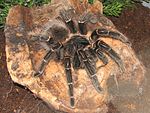Cosmophasis
Cosmophasis Simon, 1901 è un genere di ragni appartenente alla famiglia Salticidae.
Caratteristiche
[modifica | modifica wikitesto]La maggior parte delle specie è mirmecofila, cioè ha interazioni con le formiche che vanno dal commensalismo al parassitismo. Vi sono comunque alcune specie che mostrano varie colorazioni e seguono altri tipi di comportamento.
C. bitaeniata (Keyserling, 1882) secerne composti chimici in grado di far intendere alle specie della formica Oecophylla smaragdina (Formicinae) di essere una di loro e infiltrarsi nei nidi[1].
Distribuzione
[modifica | modifica wikitesto]Le 43 specie oggi note di questo genere sono diffuse per la maggior parte lungo l'Asia sudorientale fino a raggiungere l'Australia; alcune specie sono state rinvenute in Africa[2].
Tassonomia
[modifica | modifica wikitesto]

A dicembre 2010, si compone di 43 specie[2]:
- Cosmophasis albipes Berland & Millot, 1941 — Guinea
- Cosmophasis albomaculata Schenkel, 1944 — Timor (Indonesia)
- Cosmophasis arborea Berry, Beatty & Prószynski, 1997 — Isole Caroline
- Cosmophasis australis Simon, 1902 — Sudafrica
- Cosmophasis bitaeniata (Keyserling, 1882) — Nuova Guinea, Australia, Micronesia, Indonesia, isole Figi
- Cosmophasis chlorophthalma (Simon, 1898) — Nuove Ebridi
- Cosmophasis chopardi Berland & Millot, 1941 — Costa d'Avorio
- Cosmophasis cypria (Thorell, 1890) — Giava
- Cosmophasis depilata Caporiacco, 1940 — Etiopia
- Cosmophasis estrellaensis Barrion & Litsinger, 1995 — Filippine
- Cosmophasis fagei Lessert, 1925 — Africa orientale
- Cosmophasis fazanica Caporiacco, 1936 — Libia
- Cosmophasis gemmans (Thorell, 1890) — Sumatra
- Cosmophasis lami Berry, Beatty & Prószynski, 1997 — Isole Figi
- Cosmophasis laticlavia (Thorell, 1892) — Sumatra
- Cosmophasis longiventris Simon, 1903 — Vietnam
- Cosmophasis lucidiventris Simon, 1910 — Gabon
- Cosmophasis maculiventris Strand, 1911 — Isole Aru
- Cosmophasis marxi (Thorell, 1890) — Sumatra, Giava
- Cosmophasis masarangi Merian, 1911 — Celebes
- Cosmophasis micans (L. Koch, 1880) — Queensland
- Cosmophasis micarioides (L. Koch, 1880) — Nuova Guinea, Queensland, Isole Salomone
- Cosmophasis miniaceomicans (Simon, 1888) — Isole Andamane
- Cosmophasis modesta (L. Koch, 1880) — Queensland
- Cosmophasis monacha (Thorell, 1881) — Nuova Guinea
- Cosmophasis muralis Berry, Beatty & Prószynski, 1997 — Isole Caroline
- Cosmophasis obscura (Keyserling, 1882) — Queensland
- Cosmophasis olorina (Simon, 1901) — Sri Lanka
- Cosmophasis orsimoides Strand, 1911 — Isole Kei (Indonesia)
- Cosmophasis parangpilota Barrion & Litsinger, 1995 — Filippine
- Cosmophasis psittacina (Thorell, 1887) — Birmania
- Cosmophasis pulchella Caporiacco, 1947 — Etiopia
- Cosmophasis quadricincta (Simon, 1885) — Singapore
- Cosmophasis risbeci Berland, 1938 — Nuove Ebridi
- Cosmophasis squamata Kulczyński, 1910 — Isole Salomone, Isole Seychelles
- Cosmophasis strandi Caporiacco, 1947 — Africa orientale
- Cosmophasis thalassina (C. L. Koch, 1846)[3] — dalla Malesia all'Australia
- Cosmophasis tricincta Simon, 1910 — Bioko (Golfo di Guinea)
- Cosmophasis trioipina Barrion & Litsinger, 1995 — Filippine
- Cosmophasis umbratica Simon, 1903 — dall'India a Sumatra
- Cosmophasis valerieae Prószynski & Deeleman-Reinhold, 2010 — Sumbawa (Isole della Sonda)
- Cosmophasis viridifasciata (Doleschall, 1859) — da Sumatra alla Nuova Guinea
- Cosmophasis weyersi (Simon, 1899) — Sumatra
Specie trasferite
[modifica | modifica wikitesto]Sono ben 10 le specie finora trasferite di questo genere, prevalentemente verso il genere Mexcala:
- Cosmophasis archeyi Berland, 1931; trasferita al genere Clynotis[2]
- Cosmophasis caerulea Simon, 1901; trasferita al genere Mexcala[2]
- Cosmophasis cincta Denis, 1947; trasferita al genere Mexcala[2]
- Cosmophasis collingwoodi (O. P.-Cambridge, 1871); trasferita al genere Siler[2]
- Cosmophasis ichneumon Simon, 1901; trasferita al genere Orsima[2]
- Cosmophasis insultans (Thorell, 1881); trasferita al genere Margaromma[2]
- Cosmophasis natalensis Lawrence, 1942; trasferita al genere Mexcala[2]
- Cosmophasis nigrocyanea (Simon, 1886); trasferita al genere Mexcala[2]
- Cosmophasis quadrimaculata Lawrence, 1942; trasferita al genere Mexcala[2]
- Cosmophasis tristis Berland & Millot, 1941; trasferita al genere Mexcala[2]
Note
[modifica | modifica wikitesto]- ^ Nelson XJ, Jackson RR, Edwards GB e Barrion AT, Living with the enemy: jumping spiders that mimic weaver ants (PDF), in The Journal of Arachnology 2005; 33: 813–819. URL consultato il 23 marzo 2011 (archiviato dall'url originale il 7 febbraio 2012).
- ^ a b c d e f g h i j k l The world spider catalog, Salticidae
- ^ Specie tipo del genere.
Bibliografia
[modifica | modifica wikitesto]- Simon, 1901 - Histoire naturelle des araignées. Paris, vol.2, p. 381-668
- Nelson, X.J., Jackson, R.R., Edwards, G.B. & Barrion, A.T., 2006 -Living with the enemy: jumping spiders that mimic weaver ants. The Journal of Arachnology 33, p. 813-819. Articolo in PDF Archiviato il 7 febbraio 2012 in Internet Archive.
- Allan, R.A. & Elgar, M.A., 2001 - Exploitation of the green tree ant, "Oecophylla smaragdina", by the salticid spider "Cosmophasis bitaeniata". Australian Journal of Zoology 49, p. 129–137.
- Allan, R.A., Capon, R.J., Brown, W.V. & Elgar, M.A., 2002 - Mimicry of host cuticular hydrocarbons by salticid spider "Cosmophasis bitaeniata" that preys on larvae of tree ants Oecophylla smaragdina. Journal of Chemical Ecology 28, p. 835–848. DOI: 10.1023/A:1015249012493
- Elgar, M.A. & Allan, R.A., 2006 - Chemical mimicry of the ant "Oecophylla smaragdina" by the myrmecophilous spider "Cosmophasis bitaeniata": Is it colony-specific? Journal of Ethology 24(3), p. 239-246. DOI: 10.1007/s10164-005-0188-9
Altri progetti
[modifica | modifica wikitesto] Wikimedia Commons contiene immagini o altri file su Cosmophasis
Wikimedia Commons contiene immagini o altri file su Cosmophasis Wikispecies contiene informazioni su Cosmophasis
Wikispecies contiene informazioni su Cosmophasis
Collegamenti esterni
[modifica | modifica wikitesto]- The world spider catalog, Salticidae URL consultato il 23 marzo 2011, su research.amnh.org.



